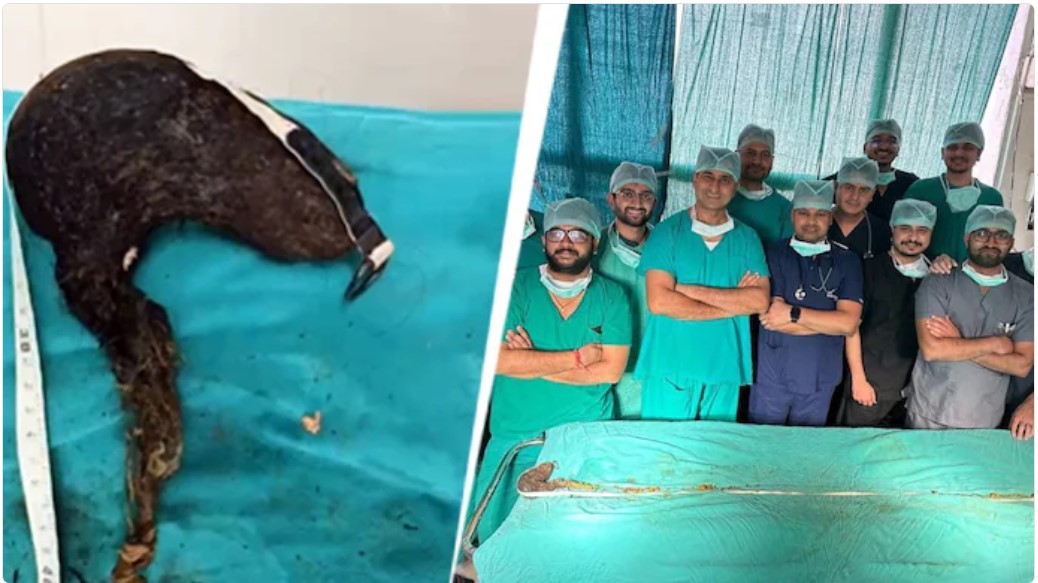In a record-breaking surgical feat, doctors at Jaipur’s Sawai Man Singh (SMS) Hospital successfully extracted a 210-centimetre-long trichobezoar, a mass of ingested hair and foreign objects from the stomach and small intestine of a 14-year-old girl. The procedure has now set a new world benchmark, surpassing the previous record of 180 centimetres.
CT Scan Reveals the Condition
The rare case involved a girl from Barara village in Uttar Pradesh’s Agra district, who had been facing severe abdominal discomfort and recurring vomiting for over a month. A detailed clinical evaluation, including a contrast-enhanced CT scan, revealed that her stomach was grossly distended and packed with an unusual mass that extended deep into her digestive tract.
According to the surgical team, extracting the hairball intact was crucial. Fragmenting it during the operation would have required additional incisions throughout the intestines. Fortunately, the mass was removed in one piece during a laparotomy that lasted about two hours. Notably, the procedure was completed without any need for a blood transfusion.
“This is the longest trichobezoar ever removed from a patient’s stomach, to the best of our knowledge,” said Dr. Jeevan Kankariya, who led the operation. “When we measured it, the hairball was 210 cm long.” Dr. Kankariya, who already holds four Guinness World Records for surgical accomplishments, confirmed that this case will be submitted for official recognition.
Teen Girl’s Hair-Eating Habit Linked to Pica
The girl, a Class 10 student, had reportedly developed a compulsion to eat non-edible substances like soil, chalk, and wooden pieces as early as Class 6. Over time, her behaviour evolved into consuming her own hair, a symptom consistent with Pica, a psychological disorder that compels individuals to eat non-food items. “She started eating chalk in school around Class 6, influenced by peers, and later began ingesting hair,” explained Dr. Kankariya.
During the surgical procedure, doctors found more than just hair in the trichobezoar. It also contained rubber bands, stones, thread, and fragments of wood indicating the variety of inedible materials the girl had been ingesting for years. The massive bezoar had extended from the stomach into the distal ileum, a portion of the small intestine, making the case even more complex.
This condition where a trichobezoar stretches from the stomach into the intestinal tract is clinically known as Rapunzel Syndrome, a rare gastrointestinal phenomenon named after the fairy-tale character known for her long hair. As defined by the U.S. National Library of Medicine, bezoars are indigestible materials accumulated in the gastrointestinal tract, and when formed of hair, they are classified as trichobezoars.
Patient is Recovering Slowly
Medical experts say most patients with such conditions have underlying psychiatric disorders. After surgery, individuals like this young girl typically require psychiatric care and long-term follow-up to prevent recurrence. Hospital authorities shared that the patient is recovering steadily and is likely to be discharged soon.
Superintendent Dr. Sushil Bhati and Principal Dr. Deepak Maheshwari also played key roles in coordinating the surgical success. The rare and high-risk procedure was a team effort, involving not only Dr. Kankariya but also Dr. Rajendra Bugalya, Dr. Devendra Saini, Dr. Amit, and Dr. Sunil Chauhan, along with their anaesthesia colleagues.
This medical success story not only brought relief to a young girl in distress but also highlighted the importance of mental health support in managing eating disorders. The surgical achievement at SMS Hospital now stands as a monumental contribution to the field of gastrointestinal surgery and will likely enter the record books.


